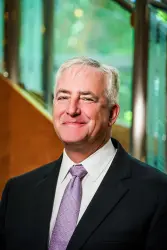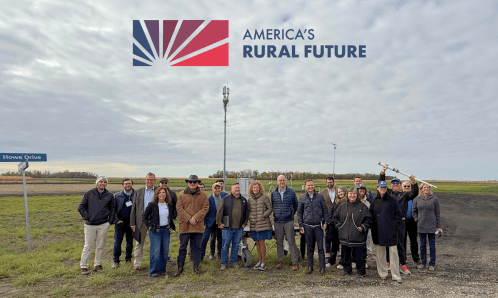Tribal communities are faced with relying on federal funds to stand in for so much of what we lost through colonization.
Allison Neswood
In this episode of Metro Blueprint, experts examine the challenges Indian Country is facing due to the disruption in federal funding. Robert Maxim, fellow at the Brookings Institution, and Allison Neswood, senior staff attorney at the Native American Rights Fund, discuss what these cuts mean to Native communities—and why non-Native audiences should pay attention.
- Listen to Metro Blueprint on Apple, Spotify, or wherever you like to get podcasts.
- Watch episodes on YouTube.
- Learn about other Brookings podcasts from the Brookings Podcast Network.
- Sign up for the podcasts newsletter for occasional updates on featured episodes and new shows.
- Send feedback email to [email protected].
Transcript
[“doors opening”; music]
PUENTES: Hi, I’m Rob Puentes, vice president and director of Brookings Metro. I’m also the host of Metro Blueprint, a podcast from the Brookings Podcast Network. Every two weeks a different Brookings Metro scholar and a guest will discuss ideas and action to create more prosperous, just, and resilient communities in America.
Since the start of the year, the federal government has been cutting funding to Native American communities. First, there was a freeze in all federal grants that go through the Office of Management and Budget. Those were followed by cuts from DOGE, the Department of Government Efficiency, as well as cuts to programs perceived as promoting diversity, equity, and inclusion.
In this episode of Metro Blueprint, Rob Maxim, a fellow at Brookings Metro, and Allison Neswood, a Navajo attorney at the Native American Rights Fund, discuss how these funding cuts are affecting Native Americans and Tribal communities and why they also matter to non-Native people.
[music]
You can learn more about this podcast on our website, Brookings dot edu slash Metro Blueprint. And now here’s Rob and Allison.
MAXIM: Thanks, Rob. Wunee keesuq. Nutusuees ap8nak keeshkee kutahanet, kah nuwôpanâm. I’m Rob Maxim, a citizen of the Mashpee Wampanoag Tribe and a fellow at Brookings Metro, where I lead our work on Native American Tribal communities.
Since the start of the year, the Trump administration has taken a variety of actions that have had a negative impact on Indian Country. In the second week of his presidency, Trump’s Office of Management and Budget issued a now-rescinded memo directing all federal agencies to temporarily pause federal grants and financial assistance. Our team at Brookings will soon be publishing research that finds that that memo, if it were to go into effect, could result in a loss of over $23 billion to Tribal communities and Native organizations.
The Trump administration then issued a series of executive actions to eliminate government offices, programs, and activities it determined to be in service of promoting certain goals, such as responding to climate change or promoting DEI initiatives. The New York Times reported a list of hundreds of words and phrases that government agencies are being told to limit or avoid using altogether as part of this effort or to flag for review if used in government funding. Among those words and phrases are “Indigenous community,” “Native American,” and “Tribal.”
Finally, the White House’s Department of Government Efficiency, or DOGE, spearheaded by Elon Musk, has worked to cut billions of dollars in federal spending through government contract cancellations, reductions in the federal workforce, and even the wholesale closure of some federal agencies.
Each of these actions has degraded the federal government’s ability to meet the needs of tribes and Native nations. Two Tribal colleges run by the federal government, Haskell Indian Nations University in Kansas and Southwestern Indian Polytechnic Institute in New Mexico, were forced to lay off about 20% of their staff and faculty due to DOGE-mandated cuts, which cause significant negative effects for those institutions’ students and communities.
In this episode, I’ll discuss these developments, their impacts on Indian Country, and the relationship between Native communities in the U.S. more broadly with Allison Neswood. Allison is a citizen of the Navajo Nation and an attorney with the Native American Rights Fund, or NARF. Allison is a member of the Voting Rights Practice Group at NARF, which engages in nationwide litigation, advocates for Native American voting rights, supports civic engagement, and assists tribes in advocating for greater voter access for their communities.
Allison also co-leads a new team at NARF that was established to protect Tribal interests in a rapidly changing federal environment. In this capacity, she serves as a NARF liaison to the Coalition for Tribal Sovereignty, a coalition of more than 40 Tribal-serving organizations that is focused on educating leadership within the Trump administration about the trust and treaty basis for federal programs for tribes, and on advocating for the protection of Tribal programs with the administration and members of Congress. You can learn more about NARF’s efforts to support the rights of tribes and Native American people by visiting NARF, that’s N-A-R-F, dot org.
Allison, welcome to the show.
NESWOOD: Happy to be here, thank you.
MAXIM: To start, can you explain what NARF is and what role you play in supporting Native American tribes and people?
[5:26]
NESWOOD: Yes, so the Native American Rights Fund, or NARF, is the nation’s oldest and largest nonprofit law firm focused exclusively on the defense of Native American rights. NARF was founded in 1970 and since our founding over 50 years ago, NARF has been guided by five priorities. They are the preservation of Tribal existence through the defense of Tribal sovereignty; the defense of Tribal natural resources; Native American human rights; holding governments accountable to Native Americans; and the development of Indian law. So, NARF represents tribes and Native people in cases that implicate these priorities.
Our fights have included the restoration of federal recognition for tribes that were terminated in the 1950s and ‘60s. We work on Tribal water rights settlements. We fight to defend lands and waters that sustain traditional hunting, fishing, and spiritual practices. We fight to ensure that Native students can wear their Tribal regalia when they’re celebrating their accomplishments. We fight to help tribes to repatriate their cultural items and the remains of their relatives from museums and old boarding school cemeteries.
And of course, Native people continue to face systematic disenfranchisement in many areas. And so our voting rights team, which I’m a part of, works to defend Native Americans’ rights to have a say in our democracy.
We do this work largely through litigation in state and mostly federal courts. But we also work on these priorities in Congress and through administrative proceedings and even in state legislatures across the country when appropriate.
MAXIM: And each of those efforts are so important for Tribal communities and Native people. And I’m just thinking about some of my own experience and the experience of our tribe and, you know, multiple items that you mentioned there are just so relevant for what we’ve been through in recent decades. I think most of our listeners understand why federal funding matters for local communities. But can you explain why federal funding matters so much for tribes, and how Tribal governments are different from other levels of government in the U.S.?
[7:52]
NESWOOD: Yeah, well, first, like other governments in the U.S. system, Tribal governments are sovereign, meaning they exercise governing authority and provide for health and well-being within their borders. The status of tribes as distinct self-governing communities predates the arrival of Europeans to the Americas and has been consistently recognized under U.S. law.
However, tribes’ ability to exercise their sovereignty, including to generate revenue to support their communities, has been curtailed in a number of ways. One thing that a lot of people don’t realize about Tribal land is that much of it is technically owned by the federal government. Under Supreme Court precedent from the early 1800s, that land is held in trust by the federal government for the benefit of Tribal communities. And this so-called trust land status has a number of implications in Indian law.
But in relation to the question at hand, that land status really complicates business investment, as you can imagine, in Tribal communities where, you know, land can’t be used as collateral and that kind of thing. And, you know, tribes would otherwise be able to leverage this kind of business activity to generate revenue, but it’s it’s restrained.
Additionally, that land status interferes with tribes’ ability to impose property taxes, as you see other governments do, further reducing that revenue potential.
The other major category of Tribal land aside from trust land is fee land. And this is land within the boundaries of a reservation that’s privately owned, whether Indian or non-Indian, it’s privately owned. And so whether Tribal or state law applies to particular activity taking place on fee land is subject to complex legal doctrine. It’s not just like, you know, you’re in Arizona so Arizona law applies. There’s been kind of a muddle in the Supreme Court about how to apply which laws when. And so that creates a level of uncertainty that can also deter business investment in those areas of the reservation.
And then that same jurisdictional complexity also limits tribes’ ability to tax that business activity that takes place on their fee lands. So, you know, these are just examples of how this sort of complex land status both deters business investment and business activity and the tribes’ ability to generate revenue through taxation.
[10:27]
In addition, tribes, unlike other governments, are restricted in their ability to issue tax-exempt bonds to spur economic development. And tribes don’t necessarily have access to state and local funding that’s provided to support infrastructure and well-being in nearby non-Tribal communities.
Finally, I think the most crucial thing to note, I think, about the importance of federal funding is that tribes prepaid for it with their land and resources. So as a result of colonization, Tribal land holdings amount to just 100 million acres. That’s only 4.4% of the over 2 billion acres that makes up the United States. So tribes today have lost the ability to leverage 1.9 billion acres of land and the resources they contain to support their communities. And this doesn’t even take into account the cost of the traumas from forced assimilation.
So, you know, in sum, what I’m saying here is that Tribal communities are faced with relying on these federal funds to stand in for so much of what we lost through colonization, and it’s vast.
MAXIM: You know, when you say that the trust land is held in, the land is held in trust for the benefit of tribes and Native Americans, I think the word “benefit” is doing a lot of work in that sense, right? Yeah.
So since the start of the year, there’s been a lot of news coverage about the ways the federal government has been cutting funding to communities and slashing the federal workforce. As I mentioned at the top, first, there was a big freeze of all federal grants that go through the White House’s Office of Management and Budget. Then you had the work of Elon Musk’s Department of Government Efficiency. A recent analysis by Zoe Kendall at GovExec found that nearly a third of all grants canceled by DOGE contained the word Tribal, making it the single most commonly flagged keyword in the database.
And then all of that has been underscored by the ongoing cancellation contracts and firing workers who are supposedly supporting DEI initiatives. That’s a lot all at once. Can you talk a bit about how all these intersecting funding cuts and staff reductions are impacting Native Americans and Tribal communities?
[12:59]
NESWOOD: Yeah, I think it’s been a really confusing and scary time for a lot of tribes. When the OMB funding freeze you mentioned first came about, funding in areas as crucial as, you know, public safety, housing, and health care all seemed to be impacted. This is like the doctors and the police officers and the, you know, housing units and the actual services that that are so crucial in our communities.
And this really felt like life or death, honestly, for many tribes and the Tribal organizations that were scrambling to find some clarity when none was forthcoming from from the agencies. You couldn’t even sort of find somebody who knew what was going on or how to address the issues.
Now, much of the funding that was initially locked up has become available again. However, this isn’t completely the case. Federal funding supporting a broad range of needs from broadband access to Tribal economic development and climate resiliency to historic preservation and workforce development to Tribal colleges—funding in these areas continues to be withheld or up in the air, not sure what’s going to happen with it.
And as you mentioned, tribes are seeing some of their federal grants and cooperative agreements get flagged for termination under the administration’s executive order on DEI and climate justice initiatives.
And, you know, these things go to what we were talking about earlier, just more limitations on the ability of tribes to generate revenue, create resources, or provide resources for their Tribal communities in really challenging ways.
[14:xx]
And complicating things further is the administration’s effort to drastically reduce the federal workforce, as as you mentioned. Unlike in other contexts, the federal government is a direct service provider when it comes to many Tribal communities. So when it comes to firing federal workers, there were, you know, fears that doctors and teachers and police officers employed by the federal government to work in Tribal communities would be fired. And this was really untenable in health, education, and law enforcement systems that were already severely underfunded and staffed at just a fraction of need.
And we did see these concerns come to pass in the education context, as you mentioned, under the administration’s executive order regarding the firing of probationary employees—nearly a quarter of staff at Haskell Indian Nations University and Southwest Indian Polytechnic Institute were fired. And this included professors, maintenance and cafeteria staff, and student support staff.
And the firings resulted in classes being canceled. Students didn’t know if they were going to be able to walk at graduation on time or ever. It resulted in safety issues. In the elimination of career and scholarship support services when students were, like, waiting at the beginning of the semester for their financial aid to come through. And really just significant challenges on campus.
And NARF sued to challenge these firings. And our clients in the case, including students from Haskell and SIPI, they expressed real fear that they wouldn’t be able to finish their education at these institutions or at all because of ability to afford college elsewhere.
And in addition to NARF’s lawsuit, there was significant outcry and strong advocacy from Indian education groups. And the staff at Haskell and SIPI were thankfully hired back. But the situation illustrated the severe impacts cutting federal staff could have on Tribal programs because these staff are really directly involved in providing services.
[17:02]
But I also want to note that even federal agency staff that aren’t involved, you know, in direct services do have a big impact on Tribal programs when they’re let go. The firing of federal employees that administer federal programs for tribes has largely been at least paused pending Tribal consultation. However, those same employees have insisted, I think fairly, that they have the same access to those voluntary resignation and early retirement programs that are being offered to other federal employees.
And we’re seeing big impacts from that. As a result of these staff leaving and Tribal programs are losing critical institutional knowledge about those Tribal programs and about how the agencies administer and uphold Tribal sovereignty.
And those losses have resulted in funding interruptions even where funding isn’t being intentionally withheld by the administration. So yeah, we see departments that are supposed to be administering Tribal programs, and, like, the one person with the authority and the know-how to, you know, make the payments is is gone. So there’s a bottleneck where that funding can’t get through and tribes don’t know who to talk to. You know, offices of 10 or 12 are reduced to 2 to 3 lower level staff. And it’s really, again, creating that bottleneck for for federal funding, even where there’s not the intention of cutting off federal funding.
MAXIM: I think that last point around the experience of staff and the experience of federal and other government employees is so important. We have some forthcoming work that we did in California that’s going to be published a little later this summer focused on state and regional government agencies there. And one of the findings that we have from our qualitative work with Tribal leaders is that there can be extreme variance between different departments and agencies or even across offices within a single department based on the personnel and the experience that those individuals in government positions have in working with tribes and working in Indian Country. And so when you lose that staff, you know, when you lose that experience, knowledge of interacting with tribes and of the trust and treaty relationship that we’ve been talking about, it really does have a pretty critical impact on the ability of governments to work with tribes. And so I I totally hear that.
And when I think about the Haskell and SIPI side of things, those those universities, the other unspoken part of it too is these are institutions that have faced challenges around funding and administration in the past, but in recent years have really been on the upswing.
And so these types of funding cuts, when they come in, even if they’re temporary, they disrupt the ability of these institutions to grow and to build Native sovereignty, right? I mean, even if it’s just temporary. And students may be hesitant about going to a school that risks funding. Institutions may be hesitant to invest in infrastructure that’s needed to expand them, and it all impacts Tribal sovereignty.
[20:22]
NESWOOD: Yeah, and, you know, we represent a few tribes in that lawsuit as well. And what they told us was they had developed relationships with the school to develop programming that would really address the needs of the tribe, you know, for child development, employees, or for different types of jobs that are needed on the reservations.
But, you know, again, they expressed concern that, like, should we be sending our Native students here if they’re going to be subject to these funding cuts? And it’s a really challenging place for tribes to be, especially because these schools are really, like, you know, focused on building the Tribal leaders of the future.
MAXIM: So as we’ve been discussing, the administration seems particularly focused on stamping out funding to any initiatives it claims are in service of DEI. From my end, I think they’re really using DEI as a cover to roll back civil rights protections for historically protected groups.
And while I think that’s an important topic of discussion that needs to frankly be talked about more widely, when it comes to funding cuts for Native Americans and tribes, I and many others, and you talked about this earlier, have argued that the DEI framing actually isn’t even relevant. That’s because federal funding to Native American people and tribes isn’t based on race, but on the political government-to-government relationship between tribes in the United States. Can you talk a bit more about this distinction and how you’re approaching it in your work?
[22:03]
NESWOOD: It is important to acknowledge the unique legal basis for federal support to tribes. That support is provided to Tribal communities pursuant, as you suggested, to the federal government’s trust and treaty obligations and to the unique government-to-government relationship between tribes and the U.S. And, you know, according to the Supreme Court and Supreme Court doctrine, this means, as you suggest, that federal funding to Native American people isn’t based on race, but rather on their political status as citizens of sovereign Tribal nations.
And so the strongest advocacy for our Tribal programs, particularly in this political environment, does require clarity on that point. And, you know, tribes and and advocates and NARF are trying to do a lot of work to make sure that that’s clear.
And here I’d really like to call out the work of of the Coalition for Tribal Sovereignty, which you mentioned at the top. This is a collaboration of NARF, United South and Eastern Tribes, Sovereignty Protection Fund, the National Congress of American Indians, and about 40 other organizations that serve Tribal communities. And the Coalition is really leading the charge in efforts to educate leadership in the new administration about the trust and treaty basis of federal programs for tribes, and in advocating for the continuation and full funding of of those programs.
So, you know, for your listeners, if they’re interested in guidance on how to understand or talk about and advocate for Tribal programs, I really recommend that people visit the coalition’s website at TheCoalitionForTribalSovereignty dot org. It has, you know, several letters that the coalition has sent to agency leadership on these topics, briefing papers, and just a lot of other materials about that trust relationship and the government-to-government relationship between tribes in the U.S.
[24:10]
And I think really illustrating the importance of that advocacy is real impact. Several agencies including the Small Business Administration and the Departments of Interior, Agriculture, Education, Health and Human Services, Housing and Urban Development, and Justice have issued guidance or statements recognizing that the implementation of the administration’s priorities, including those related to DEI and climate justice, should not impact the United States’ delivery on trust and treaty obligations. And those pronouncements have been really important in, you know, tribes’ efforts to shake funding loose, to get funding unfrozen, and in sort of slowing if not completely preventing the firing of of many federal employees that administer programs for tribes.
And also, you know, using this framework of trust and treaty obligations and the government-to-government relationship, the coalition has been able to leverage help, the help of members of Congress who are in the majority to help protect federal programs. So this language is language that members of both parties can understand and often can get behind. So it’s just really important that they think Tribal advocates and tribes are making that case and making these points clear.
MAXIM: That’s great. And just for listeners that don’t know, we’re throwing around this term trust and treaty obligations a lot and to quickly bring folks up to speed. So you mentioned earlier, Allison, idea that the U.S. holds land in trust for the “benefit,” quote unquote, of tribes and Native people. And so as a result of that and a result of multiple other kind of roles the federal government plays with tribes, the Supreme Court and others have ruled that there is a a relationship, a trust relationship, the U.S. government acts as a literal trustee on behalf of tribes in that capacity. So that’s that’s where that kind of phrase comes from.
And then the treaty side of things, the U.S. has signed hundreds of treaties with tribes, which again, under the U.S. Constitution are the supreme law of the land, governing the relationship between tribes, sometimes individual tribes, sometimes multiple tribes and the United States government. And so when we use that phrase “trust and treaty obligations,” that’s what we’re talking about.
One of the challenges I’ve had when I explain that funding to tribes isn’t based on DEI is that I do feel like I’m losing a little bit of solidarity with other historically marginalized groups. Funding to tribes and Native people isn’t based on race, but I still think it’s bad that the Trump administration is cutting funding to many Black communities, for example, as part of its so-called anti-DEI efforts. How are you grappling with this tension of explaining that funding to Native Americans isn’t based on race while still maintaining solidarity with other groups currently at risk?
[27:24]
NESWOOD: Yeah, this is such an important and I think hard question. I’m not sure I’ll have the fullest answer for you, but it is something that I sit with and grapple with. I think the first thing I will say though is that tribes have to be able to advocate for our trust and treaty rights. These rights serve as the bedrock of our continued existence as peoples and, you know, as we’ve talked about, the federal government’s delivery on its trust and treaty obligations are truly matters of life and death in our communities.
And by the way, Black Americans and other minority groups have their own unique stories of oppression and entitlement to redress for that oppression. Solidarity does have to leave room for groups who’ve been oppressed in this country to tell their unique stories of oppression and make their unique claims for justice. And I do think that that’s what tribes are doing when we’re speaking to our trust and treaty rights and our sort of unique relationship with the federal government.
However, and this is just speaking for myself here, I do hope that all Americans who are struggling in the face of oppression, from Black and Indigenous folks to immigrants and working class whites, to LGBTQ+ folks, and people with disabilities, I hope that all of us will build on the spaces created by those who came before us and explore together what unites us in this era and what can be those unifying messages and campaigns that that we can all rely on and pursue together.
And one thing I do hope we can do together is really reject any effort to define equity and racial justice as unconstitutional. We don’t have to go in that direction. It’s not preordained. I think we’re in a time of backlash to progress made in the racial justice space. And I think it’s really going to take our shared wisdom and it’s going to take supporting each other to overcome and hopefully find our way back forward.
MAXIM: I think that’s really helpful framing, I appreciate you sharing that. This has been an important discussion about how these cuts are affecting Native people and tribes. But most people listening to this podcast probably aren’t Native. In your view, and I think you touched on this a little bit in your last question or your last answer, but maybe to expand on this a little further, why does this matter for non-Native people? Why should non-Native audiences be paying attention what happens in Indian Country?
[30:06]
NESWOOD: Well, while this hasn’t always been the case in our history, I think there are a lot of Americans who are troubled by how Native Americans have been treated in this country and who want to see their country do better. You know, I think that feeling can contribute to a lot of discouragement I think people feel over the institutions in this country. And I really do think that doing right by Native people is part of restoring Americans’ faith in in their governing institutions.
But just to that point of, you know, I think people care about these issues is a small example. The Grand Canyon Trust ran a couple of polls last fall where they asked voters in Utah and Arizona for their opinions related to the Bears Ears National Monument and the Baaj Nwaavjo I’tah Kukveni National Monument on the rim of the Grand Canyon. And according to the Bears Ears poll, 75% of Utah voters support preserving Bears Ears as a national monument. And an even higher number, it was 89% of Utah voters, believe it’s very important for Native Americans to have a strong role in managing their ancestral lands. And that’s something that the Bears Ears Monument declaration provided for is that Tribal co-management. And there was a similar outcome in the Arizona poll related to the Grand Canyon monument.
And obviously this doesn’t settle the question about Americans’ attitudes towards Native Americans and their rights, but I do think it’s indicative that there are a lot of people out there who want there to be at least some measure of justice for Native people. And that justice requires that both our elected leaders and that the voters who help us hold them accountable understand our needs and how our communities are impacted by policy.
And then just as a last thing, I mean, maybe this sounds cheesy, but Native people have stewarded this land since time immemorial. And we’re facing major challenges in this country and in our world, from political crises to crises from climate change and more. And I think as stewards of these lands and as people who have survived multiple seemingly world-ending crises, I think Native people have a lot of wisdom that will help us turn the tide in this country and in our world.
But, you know, we need our health, and we need our culture to have our strength as Native people. And I think we need our strength to be part of the change that we all want to see.
MAXIM: I think that’s a good place to leave our discussion. Allison, Katapatush, thank you for taking the time to join us. And thank you for all the work that you and NARF are doing to defend Indian Country.
NESWOOD: Thank you so much for having me.
MAXIM: With the Congressional spending bill under consideration, ongoing work by DOGE, and additional executive actions on the way, federal funding flows to Indian Country will likely remain disrupted for years to come. This summer, our team at Brookings will be publishing new research, quantifying the amount of funding at risk for Tribal communities from President Trump’s federal grant freeze. In the following months, we’ll be conducting additional research on the impact of other Trump administration funding cuts on Indian Country, such as the effect of DOGE’s cuts to federal agencies.
To read this upcoming work and other Brookings research, you can visit us online at Brookings dot edu.
[music]
Kutâputunumuw. Thank you for listening.
PUENTES: Metro Blueprint is a production of the Brookings Podcast Network, found online at Brookings dot edu slash podcasts. Thank you for listening.
My thanks also to all the scholars and guests for sharing their insights and expertise, and to the team at Brookings that makes this podcast possible including Fred Dews, producer; Erin Raftery, associate producer; Gastón Reboredo, audio engineer; Daniel Morales, video editor; Leigh Balon, Brookings Metro’s director of communications; Carie Muscatello, our graphic design and web publishing manager; as well as our government affairs and promotions colleagues in the Office of Communications. Katie Merris designed the beautiful logo, and Phoebe Copeland recorded the doors audio.
For more information about us, please visit Brookings dot edu slash Metro.
I’m Robert Puentes.
[“doors closing”]
The Brookings Institution is committed to quality, independence, and impact.
We are supported by a diverse array of funders. In line with our values and policies, each Brookings publication represents the sole views of its author(s).







Commentary
PodcastHow federal funding cuts impact Tribal communities
Listen on
Metro Blueprint
July 2, 2025